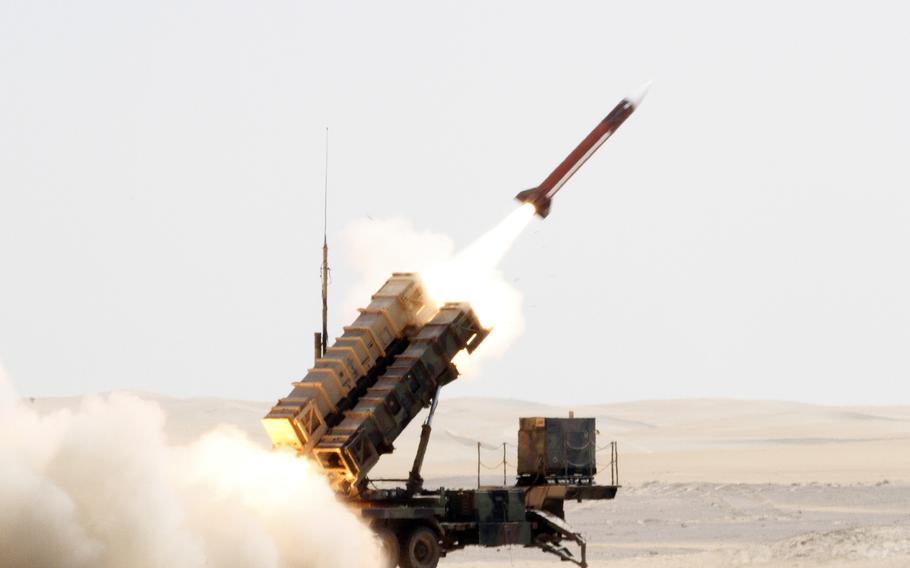
A Patriot missile is launched by soldiers at an airborne target during a live-fire exercise at an undisclosed location in Central Command's area of responsibility. U.S. troops in the Middle East are likely to stay in a fortified and defensive position until it’s clear the fragile ceasefire between Iran and Israel will hold, analysts say. ( Kyle Fisch/U.S. Army)
U.S. troops in the Middle East are likely to stay in a dispersed and defensive position amid the fragile ceasefire agreement between Iran and Israel, experts and former senior military officials say.
Tensions remain high even as the White House says it has completely destroyed Iran’s nuclear capabilities and the nations are on a path toward peace. After launching what many considered a symbolic strike on the U.S.’s Al Udeid Air Base in Qatar, Iran has agreed, along with Israel, to a tentative halt in fighting.
President Donald Trump, speaking to reporters at a NATO summit Wednesday, also said the U.S. will resume talks with Iran next week and “may sign an agreement,” though Iranian leaders have not acknowledged any talks.

President Donald Trump applauds during an address to U.S. forces at Al Udeid Air Base, Qatar, May 15, 2025. Iran launched a strike on the base June 23 in retaliation for the American bombing of three key nuclear sites in Iran. (Sean Moriarty/U.S. Air Force)
But the U.S. military is unlikely to let its guard down, as Iran and its proxies still pose a threat, according to analysts.
Bases are likely to maintain heightened force protection and keep important assets highly secured, said Becca Wasser, a senior fellow and deputy director of the defense program at the Center for a New American Security.
The military already has relocated aircraft and is likely moving supplies and munitions to facilities where they are less vulnerable to attack, Wasser said.
Satellite images show that the U.S. appeared to move planes out of Al Udeid prior to initiating Operation Midnight Hammer, which struck three high-profile nuclear sites at Fordo, Natanz and Isfahan.
If Iran provided sufficient advance warning of the attack, which the president implied in a Truth Social post, then it’s also likely that the military shifted at least some personnel out of Al Udeid.
Meanwhile, the U.S. Navy in Bahrain dispersed ships as the fighting ramped up between Israel and Iran earlier this month.
The Pentagon already has missile defense systems in the region, including Patriot batteries, which intercepted Iranian missiles targeting Al Udeid on Monday, according to U.S. Central Command.
The military has also moved dozens of refueling tankers into the theater over the past several weeks and, as of last weekend, had deployed five destroyers with missile defense capabilities to the Mediterranean Sea, according to a Friday report from USNI News.
Wasser said she expects the U.S. to ramp up passive defenses — measures as simple as installing early-warning systems or concealing assets from satellite imagery.
“We’re going to continue to see the U.S. have a distributed posture where they have removed some of the most potentially at-threat capabilities,” Wasser said.
Retired Vice Adm. Kevin Donegan, former commander of the Navy’s 5th Fleet in the Middle East, said the posture of U.S. forces is currently as alert as it could be.
“We were postured for (the) worst-case outcome just days ago,” he said during a press briefing hosted by the Middle East Institute on Wednesday. “You want to keep that posture for obvious reasons because the threat didn’t just go away.”
The U.S. has nearly 40,000 troops throughout the Middle East. In addition to bases in Qatar, Bahrain and Kuwait, forces in Syria and Iraq face threats from Iran-backed proxy militias.
Brian Carter, the Middle East portfolio manager at the American Enterprise Institute’s Critical Threats Project, noted that while Iran could fire a missile across the Persian Gulf, a militia group in Syria or Iraq could get within a few miles of U.S. forces.
Even though troops in the region may no longer be under imminent threat, Carter said, they’re not likely to stand down.
“All of these forces are on the lookout for threats from Iran, almost at all times,” he said.
Details from a preliminary Defense Intelligence Agency assessment of the U.S. bombings of Iran’s nuclear sites, reported Tuesday by The New York Times, CNN and other outlets, cast doubt on the Trump administration’s assertion that the bombs had totally obliterated the nuclear sites.
The report, according to the Times, estimated that the enrichment program had been delayed, but by less than six months.
Wasser said that while the operation might have been a tactical success, none of the facilities were entirely taken offline based on available satellite imagery.
“If Iran is drawing any lessons from this, they are drawing the lesson that they need to keep their nuclear program a secret, almost in its entirety,” Wasser said.
Speaking to reporters at the NATO summit on Wednesday, Trump lambasted news outlets for reporting on the assessment and called it “fake news.”
Defense Secretary Pete Hegseth, who was also in attendance, said that the Pentagon intelligence report was a preliminary, low-confidence look at the damage, and that he believes the impact was far more severe.
When asked if the U.S. would carry out more strikes if Iran moves to rebuild its facilities, the president said, “sure.”
“But I’m not going to have to worry about that,” he said. “It’s gone for years.”